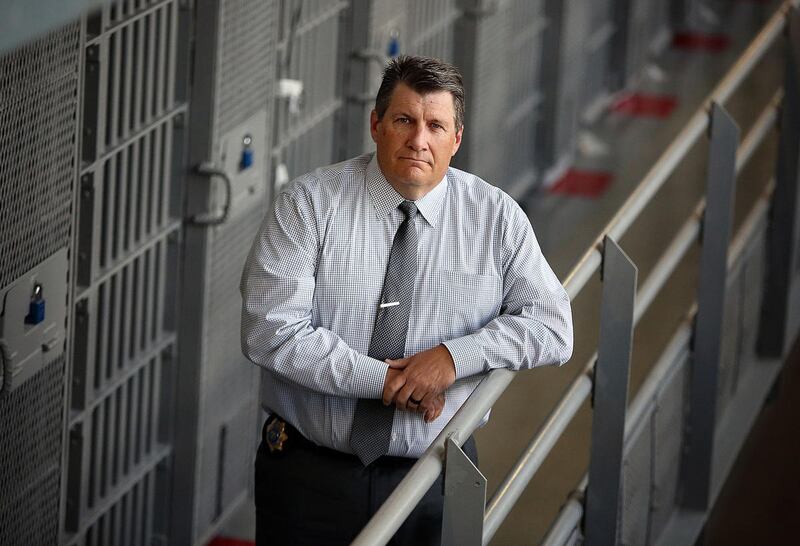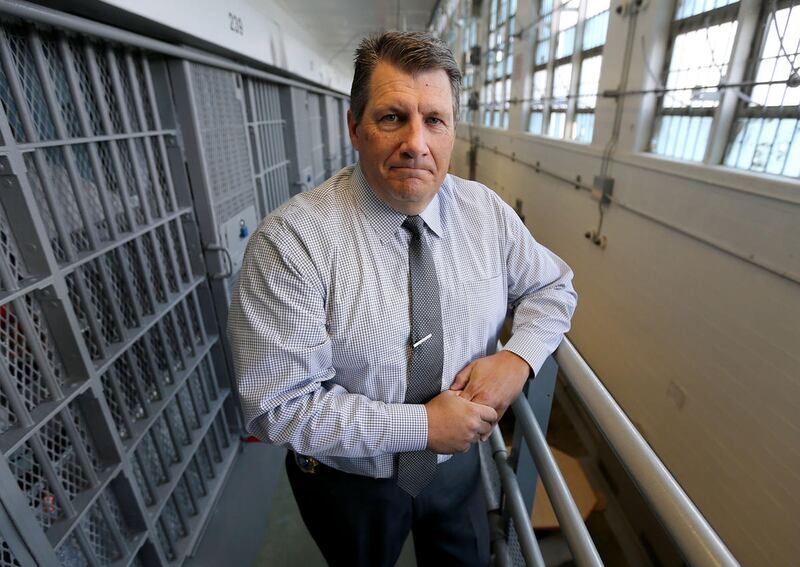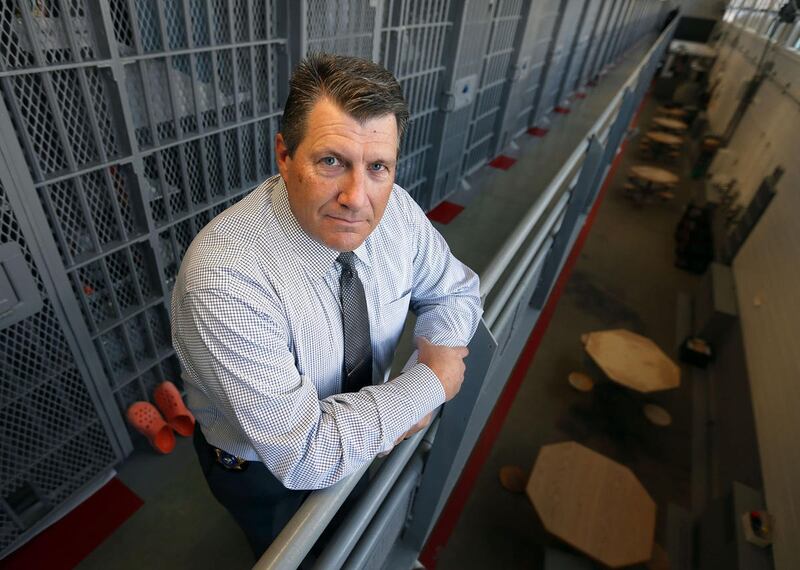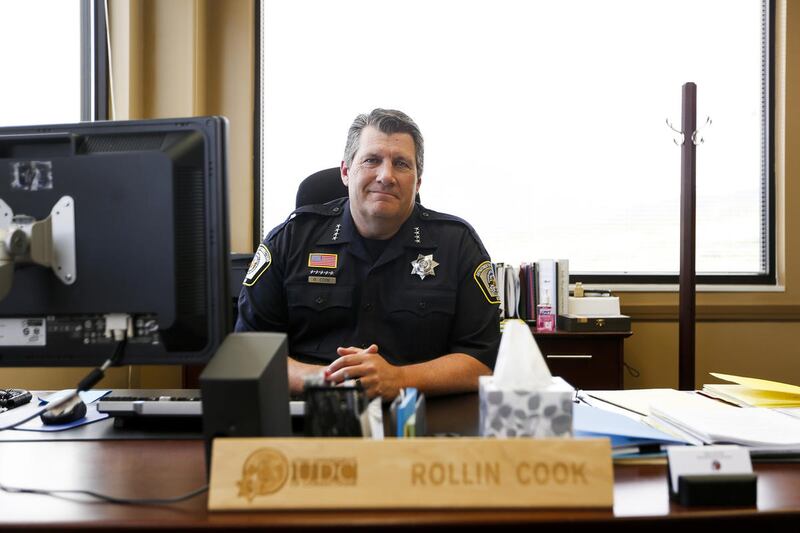DRAPER — When Rollin Cook, the man who as executive director of the Utah Department of Corrections oversees some 7,000 inmates locked up in the state prison system, was a teenager at Hillcrest High School, he landed an after-school job doing janitor work at O.C. Tanner, Salt Lake City’s world-renowned recognition awards company.
Among his duties, he cleaned the offices of founder and owner Obert Clark Tanner — the O.C. in O.C. Tanner — and company vice president Brent Evans.
His efforts did not go unnoticed or unappreciated. He recalls how Obert Tanner was unerringly effusive in his praise of how clean his office looked. And he remembers walking into Evans’ office and finding a candy bar attached to a note complimenting him on a fine job of washing the windows.
The help at O.C. Tanner, Cook discovered firsthand, got treated more like family than employees, and praised more than criticized.
Ideal training, as it turned out, for his chosen career.
“That’s really where I learned a lot of my leadership type of philosophies. It’s where I learned about how to treat people,” says Cook, who stayed at O.C. Tanner for six years, advancing from janitor to shipping clerk and finally to customer service representative as the job paid his way through the Utah Law Enforcement Academy.
When he was awarded his policeman’s badge in 1989, now in his mid-20s, his first assignment was at the Salt Lake County Jail — a decidedly different kind of customer service.
In a freewheeling conversation at his office overlooking the grounds of the Utah State Prison at Point of the Mountain, Cook talked about his Utah roots, his management style, his goals for the Department of Corrections, the new prison he helped locate and design, and what it’s like to be Utah’s top correctional leader.
Q: Thank you for this opportunity. We’re guessing not a lot of people would suspect that before you got into corrections you worked for a company that focuses on praise over punishment.
A: It’s true. It was a real culture change for me. I went from a place all about recognition to a place about nonrecognition. And it was difficult at first, I won’t lie. When I started at the jail (in 1989), being a correctional officer was more about intimidation to intimidation. They own that side of the bars; we own this side.
But corrections has changed a great deal since then. We’ve transitioned to a point where it’s more open, more about setting expectations for inmates, more about rewarding them when they do things right rather than waiting for them to mess up. They’re not convicts or inmates; they’re people, and I think we’ve gotten a lot better identifying that. In that way it’s really like the way I was treated at O.C. Tanner.
Q: What motivated you to go into law enforcement as a career?
A: I was in Scouting growing up and my scoutmaster, Sam (Cliff) Leaver, was an assistant chief in the Salt Lake City Police Department. He was a very positive role model for me. But it wasn’t just Cliff; lots of people in my life were leaders in law enforcement, and I saw it as an honorable profession.
I didn’t necessarily look at it like I was going to go kick butts and take names. It was really about having a career that people admired and gave me a chance toward being involved in the community and giving back. I grew up in Midvale, and a lot of good people helped my parents raise me: the people in my church, the people in the (LDS) ward, the people in the community, the people in the schools. I always joke I’m a Baptist born and raised in Utah married to a Catholic.
Q: How did corrections become your chosen route in law enforcement?
A: The first job opportunity that came along when I graduated from the academy was with the Salt Lake County Sheriff’s Office, and I’d heard that a great place to start was in the jail, so I chose to go there. At the time, Salt Lake County was considering building Oxbow (which opened in 1992), and I could see lots of opportunities for promotion.
I was invited to be on a transition committee to develop emergency evacuation procedures, and that led to my being promoted to leadership as a corporal. Once I had ownership, I stayed with corrections and was eventually appointed chief by Sheriff (Aaron) Kennard.
I was already doing teaching and consulting around the country when it was time to retire (in 2012), so I did that for a year, and that’s when I had some people reach out and ask if I’d be interested in becoming executive director for the state — something I’d never even considered doing.
Q: You weren’t the front-runner for that state post when it came up.
A: That’s true. I was the dark horse, the outsider from Salt Lake County. I look at some of the people who were in the department and weren’t picked and wonder why not. They’re so bright and capable.
I had opened new facilities in the past — I opened the 2,000-bed facility for Salt Lake County — and I’d gotten my master’s degree, plus I’d been teaching and consulting across the country, so I had that experience. But I was just a corrections guy. I guess that’s what the governor was looking for — a corrections guy.
Q: Did you appreciate the size and scope of the state operation before you became executive director?
A: I think it was nearly impossible to anticipate beforehand the magnitude of the things we’re responsible for. It’s much bigger than I expected.
Q: How would you describe your management style and goals?
A: The top goal from day one has been to put our employees No. 1 — empower our people, get them involved in the process so it’s not only the leaders at the top that are moving this organization. I want everyone to feel valued and that they matter and they feel proud of what they do. I believe the way I treat them is the way they’ll treat those that they supervise.
Q: What would people find most surprising about the Department of Corrections?
A: I’d say the professionalism of the staff. I think a lot of times the perception is based on the 1 percent or less of the employees who might tarnish the badge by having an inappropriate relationship or a DUI or something like that, when the reality is there are tons of unselfish people in the department doing amazing work.
Q: What percentage of the inmates could be classified as hardcore cases?
A: Probably not nearly as many as you think. I would say maybe 5 percent, and some of those are mentally unable to improve or get better. That’s one of the things that’s changed about corrections across the country — recognizing and managing the persistent mentally ill.
We’re the largest mental health provider in the state. We have more mental health beds than the state hospital. Beyond those with mental issues, there is a very small percentage in the prison population who could be considered as very dangerous and who have nothing but violence in their history. What’s interesting is when they reach a certain age, many of them grow out of it — if they live long enough to have that happen.
Q: How would you characterize the other 95 percent behind bars?
A: They’re all theoretically rehabilitatable, and they all need to be treated as individuals so they can return to the community and be something we can all be proud of.
I’ll tell you when a person’s perception changes about prison, it’s when they know someone who’s incarcerated. I receive calls all the time, “Oh, he’s a good kid. He’s never been in trouble before. Things just went the wrong way one time and he made a bad choice.” I’ve got 4,000 of them over there (at Point of the Mountain). Corrections looks different when it happens to someone you know and love.
Q: America leads the world in people incarcerated on a per capita basis. In your opinion, do we lock up too many people?
A: Yes, we do. In the 1980s and '90s, changes in the laws with such things as three strikes and mandatory sentencing, the prison population started to grow and it’s kept growing. But America is making huge strides in addressing that problem and turning it around.
The justice system is starting to figure out, OK, we’ve learned that incarceration alone doesn’t fix the problem and it’s very expensive, so let’s make investments in how we prepare these people for re-entry so they don’t come back.
Q: What in your opinion are the best strategies for reducing return visits to prison?
A: It’s key to get these folks out of their cells more often, get them education and training so they can start to grow. I’m not telling people to feel sorry for them; I’m telling them to understand where they’re coming from. Most of them didn’t have a mentor, they didn’t have concerned parents, scoutmasters, strong community support. They faced situations on the street that conspired to put them where they are.
We have a mentor program so they have someone to look up to and something to aspire to, not just send them out so they can get a job at a fast-food place. I don’t want to put the mouth on fast-food places, but we’re trying to help these folks understand that there’s hope for a future beyond crime, that you can find a job that you can actually make a sustained living at and make a difference for your future and your children’s future.
That’s where corrections is now. It wasn’t when I started, but that’s the mindset and there’s evidence things are working. What’s frustrating sometimes is it doesn’t hit the news when someone stays out of prison, is working a job, is helping their kid with homework. Sometimes they’ll get spotlighted, but it’s rare, and the reality is there are a lot of people returning from prison who are a lot better off than they were when we got them.
Q: What’s one of the first pieces of advice you give to new correctional officers?
A: One thing I always try to stress is if you’re waiting for (the inmates) to respect you first, you’re not going to get it. That’s not the way it works. You have to be able to have that internal fortitude to be able to show that respect first before you get it back.
Q: Describe a great correctional leader.
A: The same as a great sports coach. Look at the very best coaches. They’re not pushovers, but they also typically don’t demean others. They hold the respect of the people they coach. They listen to them, but they hold the line.
In Bill Belichick, the Patriots have one of the toughest coaches in the NFL, and he toes the line and everyone wants to play there. No matter what area, leaders have to be firm but fair, celebrate when it’s time to celebrate, but also hold people accountable.
Q: What do you see as the biggest misconception the public has of prisons in 2017?
A: A lot of people think we release people like in “Shawshank Redemption,” where someone’s sent out the door with an old fedora and their old suitcase, and we say, "There you go." And that’s not the way it works.
There’s a lot of emphasis on helping with transitioning back into the community. We have a huge responsibility to help individuals have a better handle on what they’re going to do and where they’re going to go.
Q: You’ve played a major role in selecting the site for the new prison and planning its infrastructure. How’s that going?
A: I’m pleased with how the process has worked. The relocation process has certainly been one of the most challenging times of my career, just trying to find a place that will work for everybody. I don’t want to jinx things because we still have to build it … but I think we’ve chosen the very best spot to put the new prison.
We’re in close proximity to all the important resources we need: correctional officers, doctors, psychologists, nurses, all the support functions. The other thing that’s great about the location is it keeps us close to the criminal justice system, it keeps us close to the families, and it keeps us close to reinvestment and community-based programs. Yet it’s far enough away that it’s not on anybody’s doorstep. You could fly over the site right now and you’d have no idea it’s a prison site.
Q: Will it have guard towers like the old prison?
A: It will not have towers. That’s corrections of the past. That’s the days where you used to have people sit up there with guns and keep the facility safe from the outside. Corrections now is security from the inside. You have a lot of electronics that keep the safety and security inside the walls.
Q: Your idea of an ideal prison?
A: First of all, it’s a facility that is safe and secure for everyone that works there, that is housed there, that comes to visit there. And it’s something that can be used as part of a criminal justice plan that allows for incarceration for those who need it. But while they’re incarcerated, it’s built with the ability to program, educate and prepare these folks to come back into our community and make a real difference.










